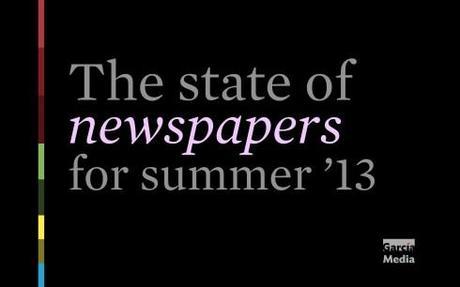TAKEAWAY: A quick glance at the headlines of the various media news outlets and one gets a clear picture of the state of newspapers for Summer 2013.

The trends are obvious and have been evolving over the past few months.
Most noticeably:
-Newspapers become attractive “trophies” to rich men who are not necessarily media barons.
-Newspapers continue to get smaller, and in the United States that means trimming the width, and often publishing less often than daily.
-Online and print editions may not work as closely together as they should.
Specifically, these are the stories that have caught my eye.
Romancing the newspapers—and their brands?
So Jeff Bezos buys that historically significant newspaper in the nation’s capital. It is, in my view, a great fix. (I will publish my congratulatory letter to Mr. Bezos in tomorrow’s blog post).
It is interesting to note that Bezos, founder and CEO of e-commerce giant Amazon, has decided to use his personal fortune to purchase The Washington Post newspaper for $250 million—-a bargain, by many experts’ accounts.
In the process, Bezos joins a select group of billionaires who find a special attraction in newspapers.
Could it be that these guys are romancing the newspaper? Or, as I imagine, that they see the brands as so powerful and everlasting, that they conceive new and traditional media marrying and living happily ever after? I think it may be a combination of both.
Another billionaire, John Henry, owner of the Boston Red Sox, paid $70 million last week for The Boston Globe, a paper The New York Times had acquired for $1.1 billion in 1993. Talk about a bargain.
The guy who started it all, and continues to startle many, is Warren Buffett who, through his company, Berkshire Hathaway, has acquired a series of newspapers, including The Omaha World-Herald, where he lives and grew up, and more from Media General.
Aaron Kushner and Eric Spitz, two East Coast investors with no newspaper experience decided to buy the Orange County Register a year ago. That newspaper continues to be watched with interest by media people globally: Kushner has hired more journalists, added pages, and increased local coverage down to the level of Little League baseball, apparently with much success.
And, by the way, all those billionaires infatuated with newspapers, forget about buying The New York Times. Its publisher, Arthur Sulzberger Jr., who is also chairman of The New York Times Company, has emphatically said that the Times is not for sale.
The Times also noted in a release that its strategy to charge customers for accessing content online remained successful. In the second quarter, the number of paid subscribers to the Web site, e-reader and other digital editions of The Times and The International Herald Tribune grew to 699,000, a jump of more than 35 percent.
Make that page narrower
Another American newspaper goes for a smaller page.
The Denver Post premiered a thinner format this week, trimming roughly an inch and a quarter from its pages, obviously, a mood to increase savings.
The slimmer, 44-inch-wide Post combines coverage of local, national and world news into one section.
This, as readers of this blog know, is something I applaud.
Readers of print newspapers do not wish to have so many sections to get through Monday through Friday. So not only is the Post’s move representing savings, but also creating a more reader friendly product.
We will see more newspapers doing this, and I hope that several will consider moving to the tabloid or Berliner formats in the near future.
One brand, four platforms
We know that the relationship of online/print editors is not always perfectly cordial, or, let’s say, based on good communications.
However, in 2013 it is much better than it was five years ago, when sometimes these guys were not even on the same floor of the building.
That is why I found it interesting to read that in Philadelphia, tensions between philly.com and the newspapers, The Philadelphia Inquirer and the Daily News are getting worse.
While they are all part of the same brand, these “tensions” apparently have more to do with the issue of ownership than with print editors who do not wish to share information with their online counterparts.
The website, like The Philadelphia Inquirer and the Philadelphia Daily News, is owned by Interstate General Media and shares content with both, but the newspapers’ sites are premium and Philly.com is free. Apparently, sometimes the website and the newspapers do not see eye to eye as to how to present content.
Perhaps it is time for “convergence”, in its true definition of the term, to come to the rescue in Philly, with a gentle reminder that, to our audiences, it is one Philadelphia Inquirer presenting information via different platforms, a voice that should be unified and based on one editorial/content/advertising philosophy.
Anything different is a media quartet that is playing off key.
Whatever the trends may be as we navigate the dogs day of August this Summer of 2013, one thing is for sure: newspapers are still a viable force with appeal to smart men with deep pockets, and who see that storytelling will always be the main driver to keep these brands alive and even profitable. When someone like Jeff Bezos buys The Washington Post he is doing more than executing a transaction, he is sending a signal to the industry: newspapers and their brands are valuable, and we need to invest in them to take them to the next level.
That’s a trend I like.
Of related interest:
http://www.ocregister.com/articles/spitz-518480-kushner-subscribers.html
http://www.bloomberg.com/news/2013-08-06/billionaire-barons-back-in-the-newspaper-game.html

